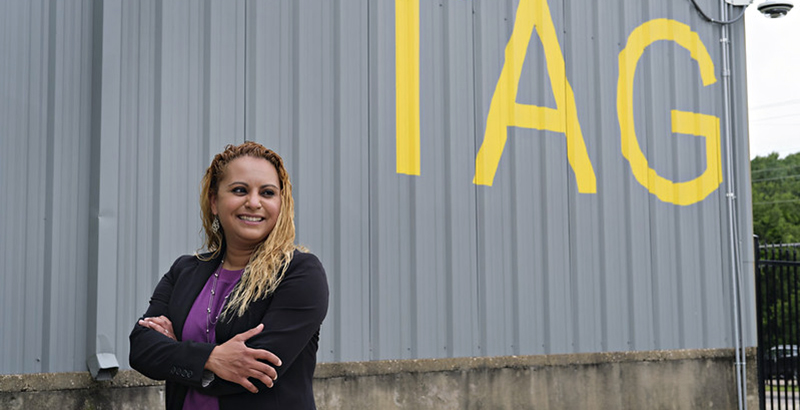Fearing a ‘Second Pandemic’ of Student Trauma, School Leaders Are Doubling Down on Mental Health First Aid Training

The Second Pandemic — Averting a Children’s Mental Health Crisis: As many children prepare to return to in-person learning and amid alarming reports from around the world pointing to an escalating crisis surrounding children’s mental health, some communities are rushing to get out ahead of the grim forecasts. In Texas, teachers and mental health care providers are fortifying support systems, investing in kids’ resilience, and expanding what works as they continue to fight for the future of the COVID-19 Generation. This is the first in a three-part series examining those efforts.
Dallas principal Ruby Ramirez knew trouble was brewing when the school counselor came to her office looking grim.
A once gregarious, curious student was disappearing before their eyes, the counselor told her, rarely speaking in class, ignoring his work and classmates, and combing his hair forward over his eyes as if to block out the world.
The bright middle schooler had been struggling with remote learning, and Dallas Independent School District’s School for the Talented and Gifted was able to convince his parents to send him to school in-person, hoping that would reignite his love of learning.
It didn’t.
The counselor also had an ominous message for Ramierez:
“He’s not the only one.”
That’s when Ramirez knew for sure: the second pandemic, the pervasive mental health challenges facing youth around the world, was at her doorstep. If her school didn’t get out ahead of it, they could lose their students. With the looming crisis, Ramierez decided it was time to revisit her Mental Health First Aid training.
“We have work to do,” Ramirez said. Once she saw students’ languishment extending beyond remote learning, enduring into the school building, she knew deeper challenges awaited. “We had gotten to a point where the desire was fading.”
It was time to prepare her staff for the challenges to come.
Mental health professionals and doctors around the globe are warning that after more than a year of stress, isolation, grief, and fear, students will not simply spring back into school. Young people everywhere from the Netherlands to Peru to the United States are reporting more anxiety, depression, and trauma symptoms.
In addition to withdrawal, increased moodiness and volatility, parents are reporting terrifying instances of self-harm, or young children expressing thoughts of suicide, which have led to a nationwide surge in hospital visits for children under 18.
The CDC reported that between April and October 2020, the proportion of emergency department visits for kids ages 5 to 11 was up 24% from the same period in 2019, the proportion of visits for 12–17 year-olds increased by 31%. Experts say the stressors of the pandemic have added to the already mounting crisis of anxiety-related disorders in young people, some as young as eight years old.
As a result, demand for the Mental Health First Aid courses is soaring among teachers, counselors, coaches — people who interact with kids, said Judith Allen, a certified Mental Health First Aid instructor.
Through her Chicago affiliate of Communities in Schools alone, Allen trained 500 adults this spring, and the nonprofit will triple instructors to meet demand this fall. The online courses made it possible for people from across the country to participate.
During her youth-oriented course — roughly seven to eight hours between the pre-work online, class session, and assessment — adult participants started by learning a foundational truth: administering first aid is not about the adult saving the day.
“You’re not a superhero, there’s no cape,” Allen said. In a session in early April, she showed the online group several scenarios where an adult might be tempted to come up with the saving insight or even offer an arm-chair diagnosis. The students in the scenarios expressing loneliness, hopelessness, and lack of motivation mirrored what parents and teachers are describing seeing more of in the wake of the pandemic.
Seeing a kid in crisis elicits a strong desire to save the day, Allen said, but rather than focusing on saying the right words to inspire, motivate, or even break through to a teen going through a mental health challenge, the training encouraged adults to be observant and open, listening to students without judgement or quick answers.
“(CPR training) does not qualify you to crack open their chest and massage their heart,” Allen told our class. She compared this to Mental Health First Aid: offering advice, diagnosis, or counseling should be left to professionals. “No one is leaving here with a doctorate in psychology or psychiatry.”
That didn’t mean walking away without new knowledge. Merely spotting trouble among adolescents can feel like something that requires just those degrees sometimes, and that’s where the course does offer tools most adults don’t already have, like looking for warning signs, indicators that something was amiss with the teen.
As students flood back into classrooms, experts are warning that the anxiety and mental health challenges could increase. Knowing the warning signs will be key to catching challenges early, getting the young person professional help, and possibly saving a life.
The course explained developmentally appropriate pulling away from family, changes in interests, and emotional expression and compared that to signs of trouble.
While most teens will pull away from family to some degree, pulling away from friends and mentors at the same time could be a sign of trouble.
Changing interests from childhood hobbies to more socially or ambitiously motivated interests is also typical. Losing interest and motivation in every area is a warning sign.
Watching the videos, it’s clear that a mental health challenge would be hard to spot from one interaction with a teenager. It was also understandable why signs were so much harder to spot over zoom: the intensity, frequency, duration of the warning sign is what Mental Health First Aid responders should note. While teachers might notice withdrawal or lack of motivation over Zoom, it was hard to tell where else that might be showing up. As Ramirez had noted, remote learning was tough for everyone, and it was hard to tell whether a child was experiencing Zoom fatigue or something more pernicious.
Teachers, coaches, and youth leaders who see the kids regularly and in person are ideally situated to catch the red flags when kids go back to school. Seeing students day in and day out will allow them to track the moods and behaviors that might need to be addressed. A bad day is going to happen, but lots of worsening bad days that extend into bad weeks is a sign of a mental health challenge.
Much of the data presented in the course helped lay people understand the difference between a mental health challenge and mental illnesses or disorders. One in five young people must manage a longer term mental illness in order to thrive, but many more will face a mental health challenge—for instance, a season of depression, substance abuse, or anxiety— during adolescence.
Thriving with a mental illness or disorder is possible if it’s properly managed, Allen reiterated during the training, just like with chronic physical conditions.
The converse is true as well. Mental health challenges can occur in people with no underlying mental illness.
That’s what’s going to be so tricky for teachers, experts warn. The conditions are right for just about anyone to have a mental health challenge in the next year. At the same time, mental illness, especially those illnesses related to trauma, will likely show itself more readily.
In some ways, Ramirez has been in the eye of that hurricane for a long time, though. Nearly half of all mental illnesses present by age 14, the last year of middle school.
Children who grow up in poverty, like 88% of the students at the School for the Talented and Gifted, are at higher risk for mental disorders, toxic stress, and trauma. They’ve also been more heavily impacted by the pandemic.
“It’s scary,” Ramirez said, “Traumas have set in for our students, in their minds, in their thinking, that are really going to hinder them forever if we don’t address them.”
Ramirez first took a Mental Health First Aid course, along with her administrative team, in 2018 through Mental Health America of Greater Dallas. Students are taught how to look out for each other as well. This year, with the increased urgency of the pandemic, 10 more staff members took the class so that a quarter of the adults on the School for the Talented and Gifted campus will be certified in Mental Health First Aid. She’s hoping to get parents to enroll as well.
“It changed the way that I saw mental health,” Ramirez said, “It helped destigmatize, for me and my administrative staff, mental health.”
For mental health support related to COVID-19, call Texas’s 24/7 toll-free support line at 833-986-1919. You can also call the National Suicide Prevention Lifeline at 800-273-8255 or text 741741 from anywhere in the country to text with a trained crisis counselor.
Get stories like these delivered straight to your inbox. Sign up for The 74 Newsletter

;)
